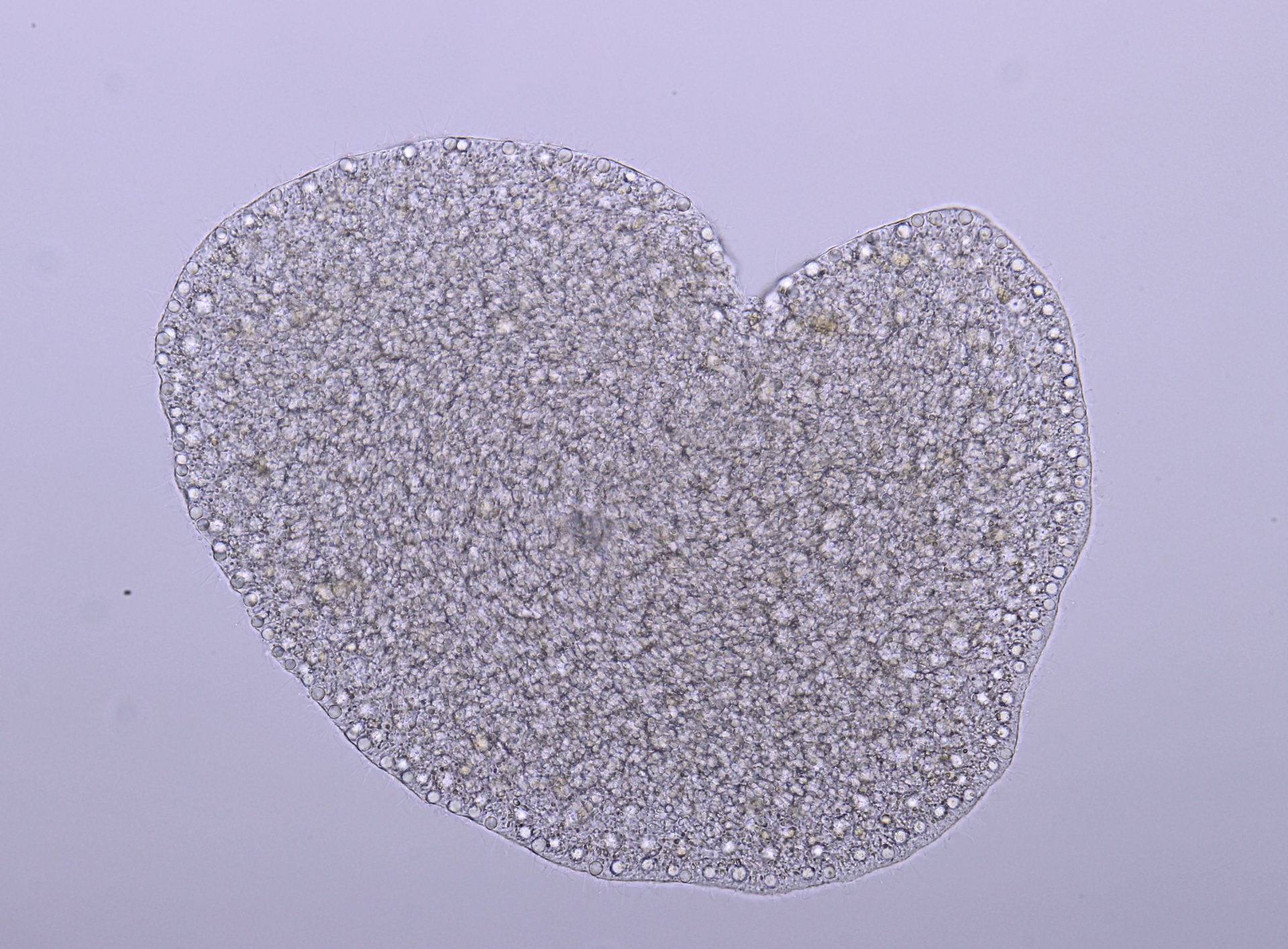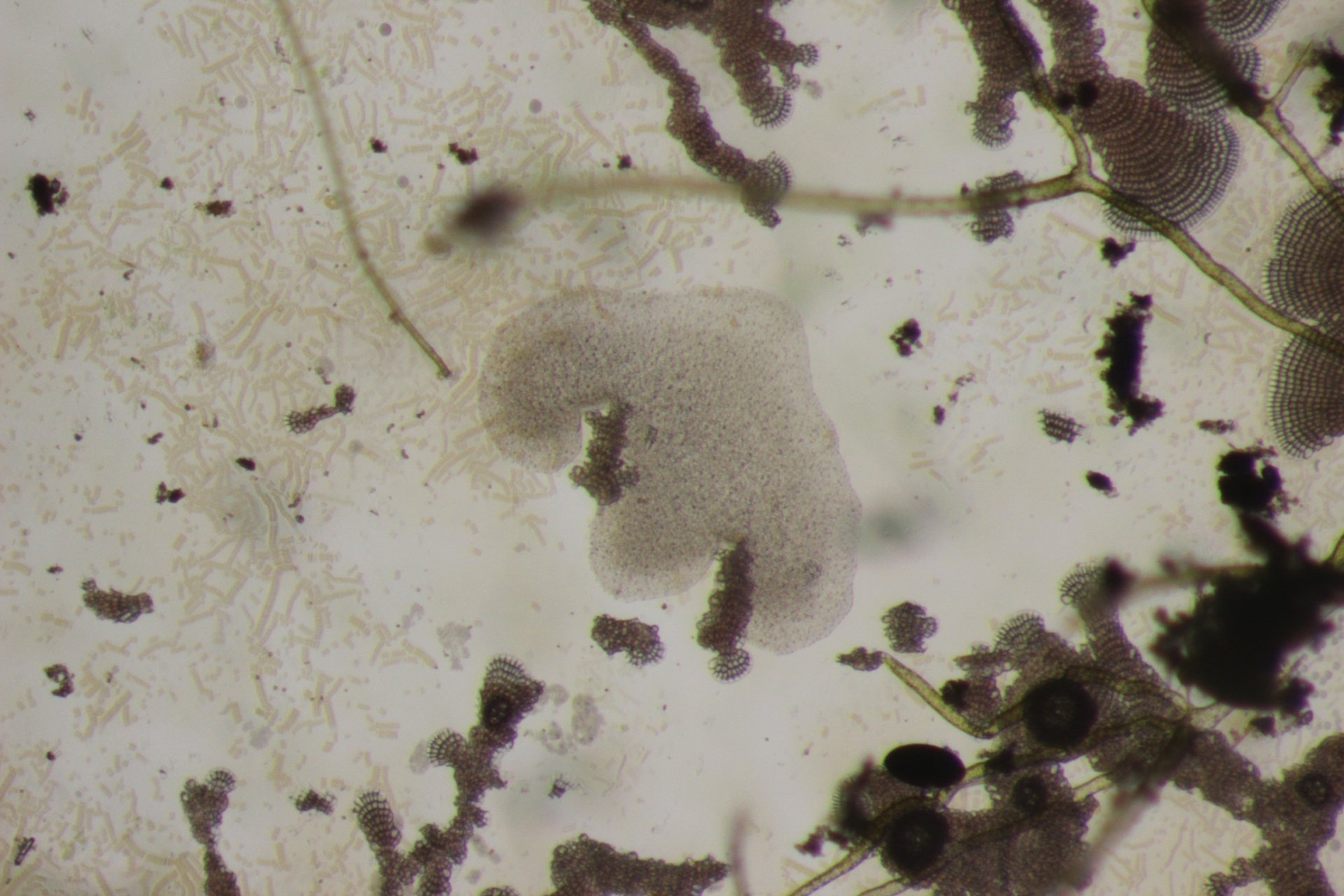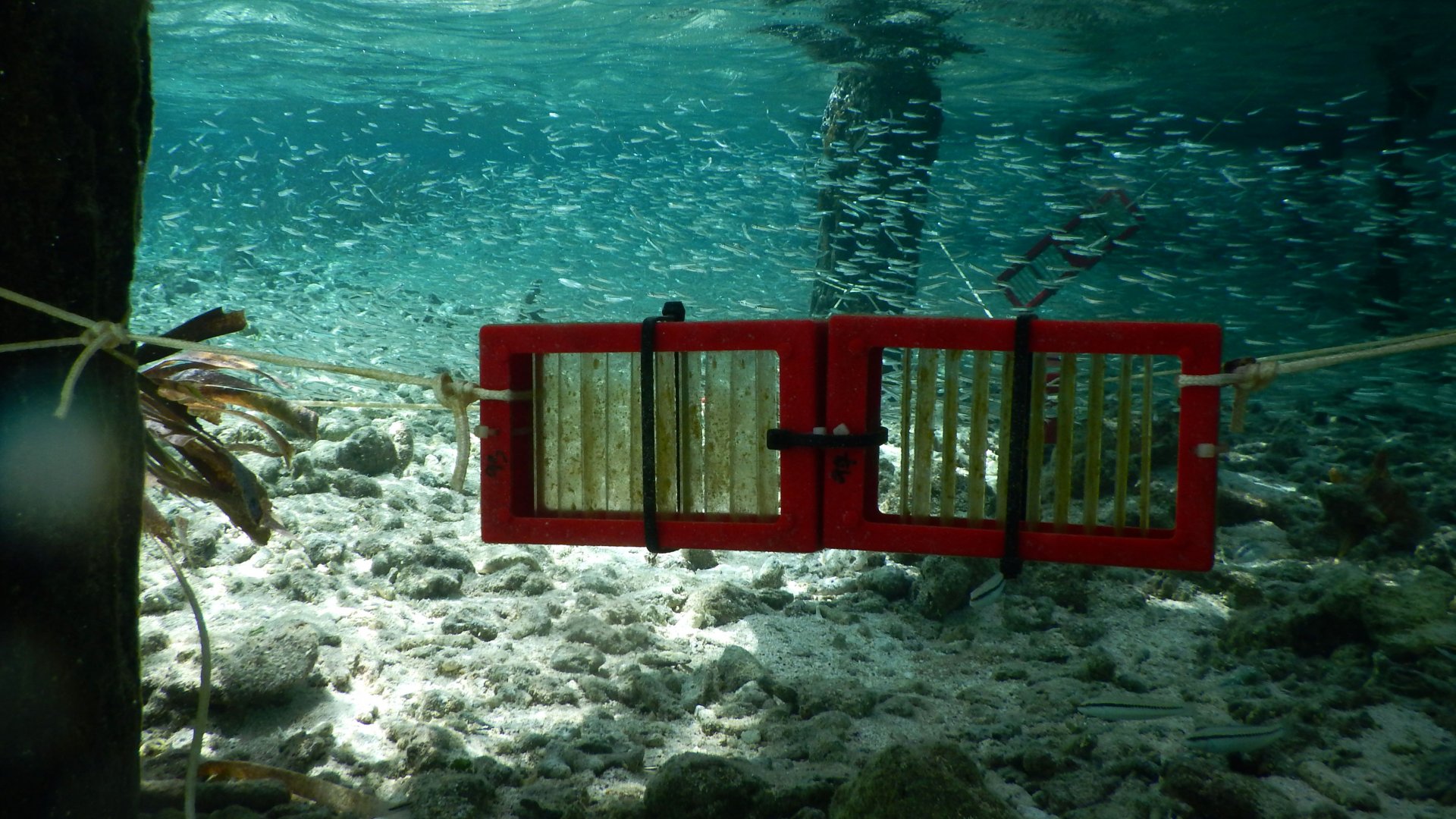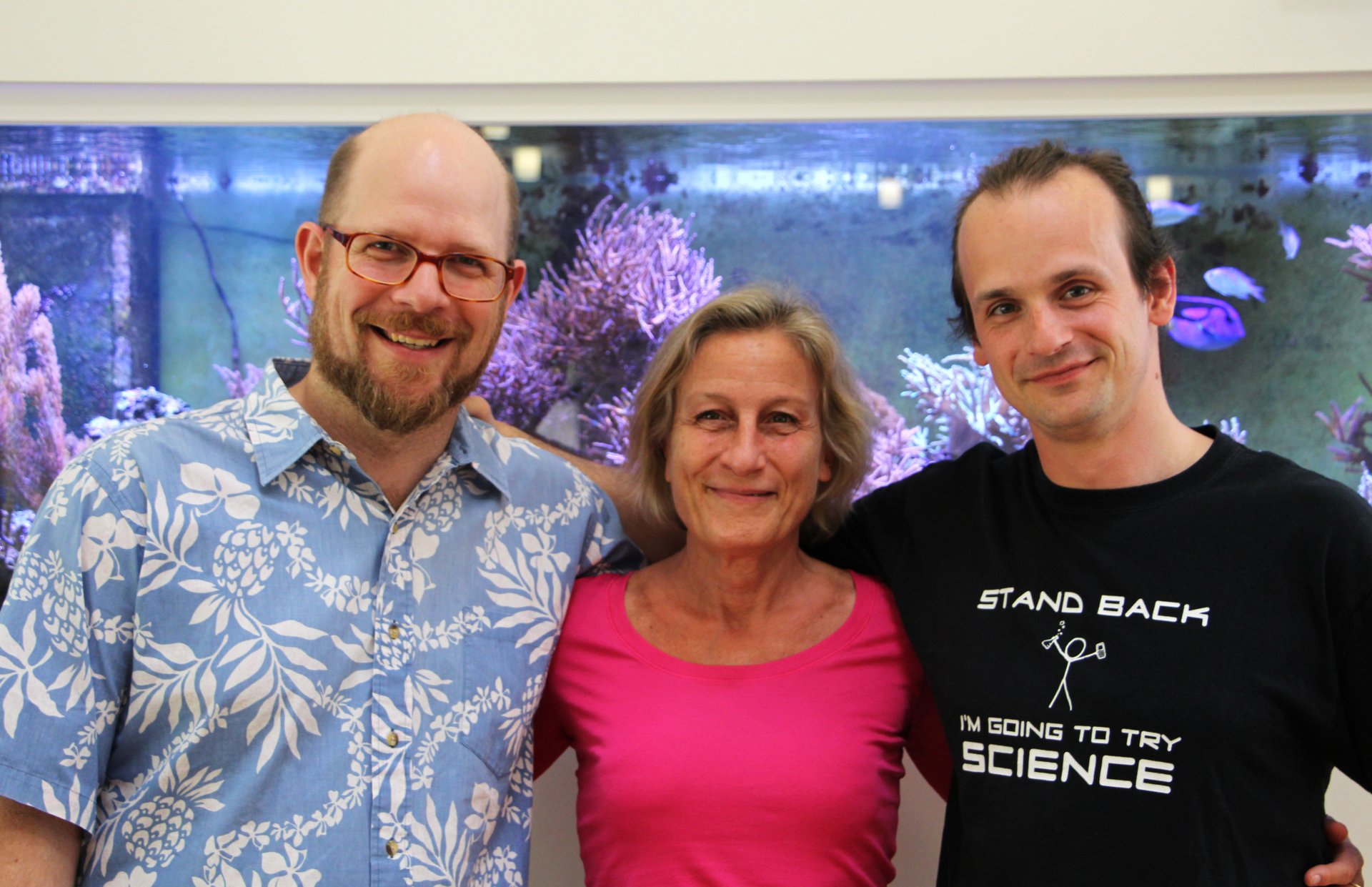- Press Office
- Press releases 2019
- Symbioses in Trichoplax
Deceptively simple: Minute marine animals live in a sophisticated symbiosis with bacteria
Trichoplax is one of the simplest animals one can imagine, and looks like a shapeless little blob. Senior author Nicole Dubilier says it reminds her of a potato chip. Trichoplax lives in warm coastal waters around the world, where it grazes on microscopic algae that cover sand and rocks. Although most aquarists may not know it, Trichoplax can also be found in almost any saltwater aquarium with corals.
Trichoplax, together with sponges and jellyfish, belongs to one of the most basal lineages of the animal kingdom. Until the 70ies, it was not even clear if Trichoplax is a proper, fully-grown animal or just the juvenile stage of a jellyfish. Only about a half a millimetre in diameter, these animals lack a mouth, gut and any other organs, and are made up of only six different kinds of cells. Its simplicity makes it a popular model organism for biologists.
Scientists from the Max Planck Institute for Marine Microbiology in Bremen, Germany, the University of Hawaii and North Carolina State University have now discovered that Trichoplax is not as simple as it looks. It lives in a remarkably sophisticated symbiosis with highly unusual bacteria.
Simple is beautiful
The first observation of bacteria in Trichoplax was nearly 50 years ago by the German zoologist Karl Grell. But no one has really taken a closer look since then. An international group of scientists around Harald Gruber-Vodicka, Niko Leisch and Nicole Dubilier from the Max Planck Institute for Marine Microbiology, and Michael Hadfield from the University of Hawaii have now investigated the bacterial tenants of Trichoplax by sequencing their genomes and using high-resolution microscopy to see where they live. “Despite being so simple, Trichoplax harbors two very different and highly unusual bacterial symbionts in its cells,” says Gruber-Vodicka. “Both symbionts are very picky – or cell-specific, as we call it. Each symbiont lives in only one type of host cell.”
Grellia – the first known symbiont to live in the endoplasmic reticulum
One symbiont, named Grellia after the zoologist Karl Grell, lives inside the endoplasmic reticulum (ER) of Trichoplax, and is the first symbiont known to permanently live in an animal's ER. The ER plays a central role in protein and membrane production. Proving that Grellia is truly in the ER was challenging. “We reconstructed a detailed three-dimensional model of the ER to show that Grellia lives inside of it, supported by the electron microscopy facility of the Max Planck Institute of Molecular Cell Biology and Genetics in Dresden,” Niko Leisch explains. “Other parasitic bacteria imitate the structure of the ER to trick the hosts into thinking they are not harmful. However, our imaging data clearly showed that Grellia lives inside its host's ER.” Intriguingly, Grellia, although closely related to parasites, doesn't appear to be harmful for Trichoplax. “Although it has genes that would allow it to steal energy from its host, it does not use them,” Leisch continues.
Ruthmannia – seeing microbial dark matter
The second symbiont of Trichoplax, Ruthmannia, belongs to a group of bacteria that were only recently discovered, the Margulisbacteria. “Before our study, Margulisbacteria were part of the so-called microbial dark matter – the vast majority of microbial organisms that biologists find through sequencing, but are unable to culture,” explains Harald Gruber-Vodicka. “We have never actually seen them, even though their genetic traces were found in aquatic samples all over the globe.” Now Gruber-Vodicka and Leisch took the first images of a Margulisbacteria. “It’s the first time we could see a member of this group. For us, observing this microbial dark matter was just as exciting as imaging black holes.” This symbiont lives in cells that Trichoplax uses to digest its algal food. "Ruthmannia appears to only eat the fats and other lipids of the algae, and leaves the rest to its host. In return, we think Ruthmannia may provide Trichoplax with vitamins and amino acids." With Trichoplax thriving in the lab cellars of the Max Planck Institute for Marine Microbiology, the authors now have continuous access to this enigmatic group of bacteria.
What’s next
“In this study, we focused on the symbiotic partners of a single Trichoplax species,” says Nicole Dubilier, Director at the Max Planck Institute for Marine Microbiology. “However, at least 20 more species have been described, and our first results indicate that each host species has its own, very specific set of symbionts. We are excited about taking a closer look at this remarkable diversity and how it evolved. These tiny animals not only look like potato chips, they also pack a crunch when it comes to what's inside them.”
Original publication
Harald R. Gruber-Vodicka, Nikolaus Leisch, Manuel Kleiner, Tjorven Hinzke, Manuel Liebeke, Margaret McFall-Ngai, Michael G. Hadfield, Nicole Dubilier: Two intracellular and cell type-specific bacterial symbionts in the placozoan Trichoplax H2. Nature Microbiology. DOI: 10.1038/s41564-019-0475-9
Behind the paper
Harald R. Gruber-Vodicka: A simple animal reveals fascinating insights in intracellular symbionts. Nature Microbiology Community.
Participating institutions
- Max Planck Institute for Marine Microbiology, Bremen, Germany
- University of Hawaiʻi at Mānoa, Honolulu, USA
- North Carolina State University, Raleigh, North Carolina, USA
- University of Calgary, Alberta, Canada
Please direct your queries to
Guest
MPI for Marine Microbiology
Celsiusstr. 1
D-28359 Bremen
Germany
|
Room: |
2245 |
|
Phone: |
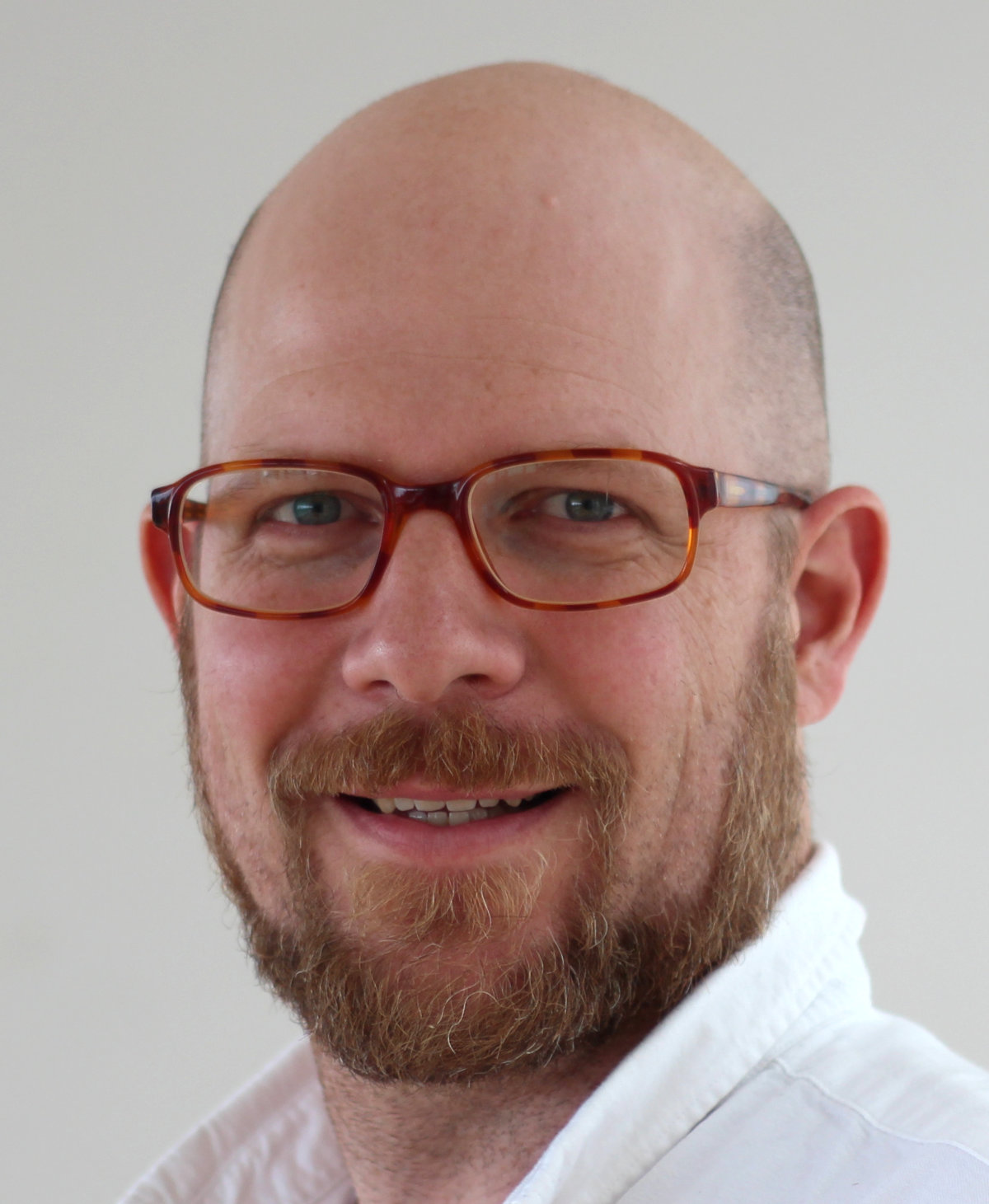
Director
MPI for Marine Microbiology
Celsiusstr. 1
D-28359 Bremen
Germany
|
Room: |
3241 |
|
Phone: |

Head of Press & Communications
MPI for Marine Microbiology
Celsiusstr. 1
D-28359 Bremen
Germany
|
Room: |
1345 |
|
Phone: |

